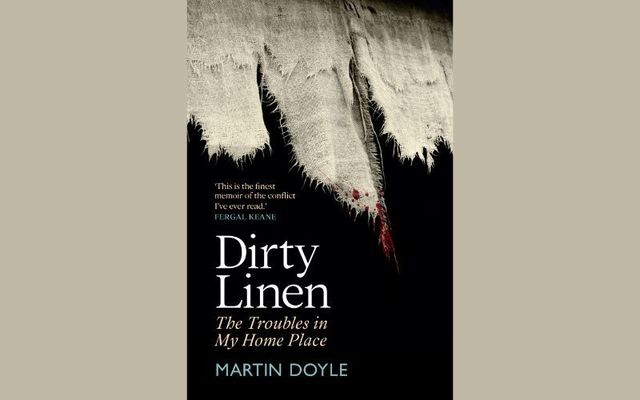"Dirty Linen" is a powerful and intimate book, beautifully written by Irish Times Books Editor Martin Doyle.
It is a personal, searing history of the Northern Ireland conflict seen through the microcosm of a single rural parish where Doyle grew up. The parish is Tullylish on the banks of the Bann, near Banbridge, Co Down, halfway between Belfast and the border.
Tullylish was on the edge of the Murder Triangle, the scene of some of the most horrific killings of innocent men, women, and children in the North by the IRA and UVF. Ordinary Catholics and Protestants were the easy targets for revenge killings by paramilitaries who randomly shot and maimed the people in the middle, hardworking family people, who believed in peaceful persuasion to support reconciliation.
“These victims were the mortar that held the North together, the best of us,” notes Doyle, “the ones who crossed the aisle without even giving it a thought.”
The “Troubles” began in Tullylish after the civil rights movement was started by Austin Currie, John Hume, and Bernadette Devlin to end discrimination against Northern Irish Catholics. British loyalists soon violently attacked these peaceful marchers determined to protect Protestant Unionist supremacy in the North. Catholics were burned out of their homes in Belfast, with the police standing by.
The Catholic, nationalist community then resorted to armed self-defense but, Doyle says, that quickly deteriorated into tit-for-tat car bombs and murders that terrorized ordinary people again, and again.
Doyle is critical of the British Government’s failure to investigate security force collusion in some of the killings of nationalists during the conflict. He singles out the Legacy Act as an attempt to bury the truth.
In Doyle’s own small parish where 30 people died violently between 1972 and 1993, he returns to the region to interview those who lost loved ones or were themselves grievously injured. Names that were just brief headlines on the news are brought to life, people who, in contrast to those who murdered them, have not been celebrated on the honor roles of gable walls or at crossroads.
Given that most people want to forget the atrocities of the Troubles, this book would be depressing except that its fast-paced, vivid dialogue and human empathy lift the human spirit by highlighting the courage, grace, and grandeur of the victims.
“I felt privileged to be in the presence of people whose resilience and undying love restored my faith in humanity,” Doyle graciously concludes.
The author’s feel for the North and his extraordinary interviews and research are captured in chapter titles such as Bigotry on the Bann, A Booby-trapped Playhouse, “They Kill Us for Their Sport,” The Showband and the Silencer, A Cold House for Catholics, Women as Victims of Man’s Stupidity, “You’d not get a softer target than Pat.”
Many of the murders Doyle describes continue to haunt, most vividly that of Pat Campbell, a keen amateur boxer, a teetotaler, and shop steward in Down Shoes, the biggest employer in Banbridge. Pat was not political and although he was a Catholic, he formed a close friendship with a man in the Orange Order.
But divisions were fostered in the town by the UDA and IRA in 1972, the bloodiest year of the Troubles. For example, following the IRA killing of James Elliott, a local delivery driver and part-time UDR corporal married with three children, Catholic homes were firebombed in Banbridge, a town where nationalists and unionists had lived peacefully side by side.
On October 29, 1973, Pat Campbell was murdered by two men in his home in front of his wife and three children aged 11, 10, and 7. Even though his wife identified the gunman, Robin Jackson, a UDR man, he was “protected by members of the RUC’s Special Branch and went on to kill more than fifty others as part of the Glenanne UVF gang.”
This gang and the role of the British Army's top spy within the IRA, Stakeknife, are under investigation by Jon Boutcher, the new Chief Constable of the Police Service of Northern Ireland, who is due to report soon on his investigations into alleged security force collusion with loyalist murders.

Looking for Irish book recommendations or to meet with others who share your love for Irish literature? Join IrishCentral’s Book Club on Facebook and enjoy our book-loving community.
"Dirty Linen" explores the murders of both innocent Protestants and innocent Catholics, including those cynically described as “legitimate targets.”
In 1982, a bomb exploded in Banbridge, “one of five bombs set off by the IRA that day in the North in acts of human butchery.” Alan McCrum, an 11-year-old farmer’s son, was waiting for a lift home from school in a local jewelry shop when a bomb killed him. Dickson McCrum, Alan’s uncle, said, “We want no retaliation. We are a sincere Christian family and accept Alan’s death as something which the Lord himself has allowed.” Doyle notes that such Christian restraint “was the bedrock, the backstop that saved the North from sliding into all-out civil war.”
Indeed, church leaders of all persuasions worked tirelessly over 30 long years for peace and tolerance, joined by moderate politicians in condemning the sectarian cruelty and savagery of the paramilitaries on both sides.
Doyle relates the bias against Catholics in Banbridge Academy, a state school where he was educated. But he also tells us how this bigotry was sometimes successfully resisted.
A Catholic student, Paula Jordan, two years ahead of Doyle, was 12 when the Religious Ed teacher said the reason Catholics went to confession was that was where priests told them who they should kill next. Paula stood up in front of 31 Protestant students and walked out in protest. As she stood outside the classroom in the corridor, she expected to be expelled but later recalled, “the next thing there was a round of applause and the whole 31 of them trooped out behind me.”
"Dirty Linen" in many ways is echoed in visual terms by Colin Davidson, one of Ireland’s leading portrait painters. Doyle writes that Silent Testimony, Davidson’s portraits of 18 relatives of victims and survivors “reflect suffering that no one deserves.”
Davidson explains, “It wasn’t about the past. It was looking at the legacy of what we have left behind in this place.”
One of his portraits is of Margaret Yeaman, a mother of four who worked as an estate agent in Banbridge. In 1982, the IRA exploded a bomb that shattered her eyes. Margaret, who suffered terribly both physically and mentally, later became friends with Jennifer Nern, a 17-year-old Catholic both of whose legs were blown off in the IRA Abercorn restaurant bombing in Belfast which killed two young women and mutilated over 130 people. "Dirty Linen" tells the story of these two women’s successful campaigns with WAVES, the victims’ group, to secure a pension for victims of the violence.
The thousands of innocent victims during the Troubles have not received a memorial in the town square, but Martin Doyle has done them and us a great service in bringing them to life.
"Dirty Linen" should be read by everyone who cares about and loves Ireland. In the words of the historian Kim Wagner, quoted by Doyle, “We are not responsible for the past, but we are responsible for what we choose to remember and what we choose to forget.”
"Dirty Linen: The Troubles in My Home Place" by Martin Doyle. Irish Academic Press, €24.99.




Comments